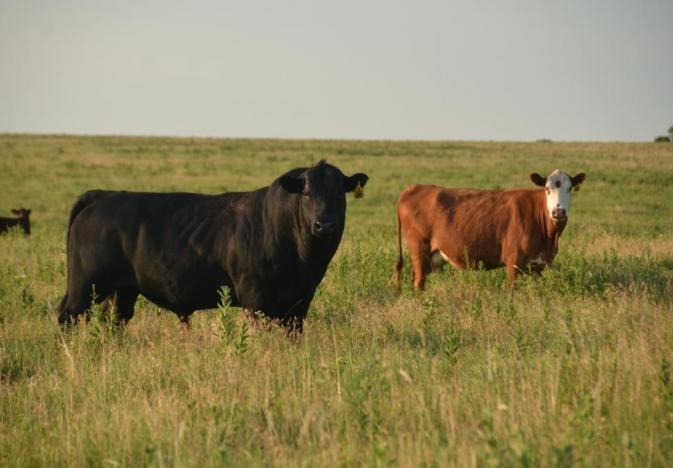
Agricultural News
OSU's Glenn Selk Talks High Pressure Heat Domes and How They Can Affect Your Beef Cattle
Wed, 10 Jul 2019 10:36:36 CDT
 Dr. Glenn Selk, Oklahoma State University Emeritus Extension Animal Scientist, offers herd health advice as part of the weekly series known as the "Cow Calf Corner" published electronically by Dr. Peel and Dr. Glenn Selk. Today, Dr. Selk discusses the impact of high pressure heat domes on cattle and how understanding that can help producers better plan for their breeding season.
Dr. Glenn Selk, Oklahoma State University Emeritus Extension Animal Scientist, offers herd health advice as part of the weekly series known as the "Cow Calf Corner" published electronically by Dr. Peel and Dr. Glenn Selk. Today, Dr. Selk discusses the impact of high pressure heat domes on cattle and how understanding that can help producers better plan for their breeding season.
"During the very hot, dry summer of 2011, the late Dr. Dave Sparks, Oklahoma State University Extension Veterinarian wrote a very comprehensive article about heat stress in cattle and livestock in general. Dr. Sparks' understanding of heat stress came from years of veterinary practice in Southern Kansas and as Extension Veterinarian in Eastern Oklahoma. His thoughts seem applicable nearly every summer in Oklahoma. The following are some key excerpts from that article:
"'Unlike horses and humans, cattle, sheep, goats, and pigs do not sweat, at least not in amounts sufficient to be beneficial for body cooling. They maintain their body temperature at or near a constant, normal, level by panting. This moves air across the highly vascular and moist mucous membranes of the mouth, tongue, and nasal passages, thus cooling the blood passing through these tissues much like the water in an engine is cooled as it passes through the radiator. For this to occur they need a lower environmental humidity and adequate water for evaporation on the surface of the membranes. If livestock are not able to maintain their normal body temperature they start to show signs of reproductive compromise first, followed by heat exhaustion at about 105 F, and cell breakdown and death at about 107 F.
"In extremely hot weather it is normal for body temperatures to rise moderately above normal during the heat of the day and to cool off at night when environmental temperatures are less. It takes several hours, however for this to occur. Although air temperatures often decline in the late afternoon or evening the animal's body temperature may not fully recover its normal level until 2 or 3 o'clock in the morning after several hours of cooler temperatures. Because of this, taking the temperature to determine if an animal is sick is best done early in the morning to get a true indication. If you must "work" or handle livestock during hot weather, do it as early as possible in the morning and be finished before their body temperature starts to rise -..'
"'In hot weather the first thing to suffer in your herd is reproductive efficiency. Reproductive problems can range from poor fertility to no fertility. In some males high core body temperature causes suppression of libido, but that is only the beginning of the problems. In male mammals the testicles cannot produce or maintain sperm cells at body temperature. The scrotum is designed to keep the testicles several degrees cooler than the body's core temperature by means of special muscles that lower the testicles away from the body as air temperature rises and pull them back closer as air temperature decreases. Also, the pampiniform plexus is a heat exchange unit that cools the blood entering the testicles. When these mechanisms are overcome by the environmental temperature problems occur. Sperm cell formation, or spermatogenesis, starts to decrease when the testicular temperature rises as little as 1/2 degree and sperm cells start to die if the testicular temperature rises as much as 2 degrees above optimum. This can be significant because if extremely hot weather causes the death or deformation of sperm in the male system it can take as long as 6 weeks for new cells to be formed and mature. This can result in a temporary sterility. Research has shown that in females, high body temperatures can result in lowered conception rates and embryonic death. Excessive heat affects embryo survival and fetal development most markedly during the first 21 to 30 days after breeding-.'
"When the reduced fertility of the male is multiplied by the reduced conception rate and embryo survival in the female, it becomes apparent why reproductive rates in cattle in late July and August are often quite disappointing.
"Dr. Sparks understood that breeding seasons in the Southern Plains must be planned so as to avoid the mid to late summer time frame when high pressure heat domes tend to reside over this area of the United States."
WebReadyTM Powered by WireReady® NSI
Top Agricultural News
More Headlines...





